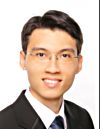 Goodpack's IBCs staked to fit a 20-ft container (top), and when collapsed and nested (bottom).
Goodpack's IBCs staked to fit a 20-ft container (top), and when collapsed and nested (bottom). Winston PeakGOODPACK is a relatively low-profile company that AmFraser Securities analyst Winston Peak (left) considers to have a resilient business model.
Winston PeakGOODPACK is a relatively low-profile company that AmFraser Securities analyst Winston Peak (left) considers to have a resilient business model.He met up recently with Mr Michael Liew, an executive director of Goodpack, to understand more about its unusual business and its No.1 position in its industry globally.
Listed on the Singapore Exchange in 2000, Goodpack supplies and leases containers to ship natural rubber, synthetic rubber, fruit juices and other products.
Today, it owns 1.9 million containers while its nearest competitor has 60,000 containers of a different design.
Goodpack’s containers are ever on the move in 68 countries around the world, shipping cargo, being emptied and cleaned, or being transferred to another destination for loading again.
Winston initiated coverage of the company yesterday (Mar 25), recommending a ‘buy’ on Goodpack shares.
His fair value for the stock is 93 cents (compared to a recent transacted price of 63.5 cents) using a discounted-cashflow model and representing 8.9 times his forecasted earnings for the year ending June 09.
He forecasted revenue of US$111.8 m (+12.2% y-o-y) and net profit of US34.3 million (+13.7% y-o-y) for FY 09.
Winston’s main considerations for investing in Goodpack and the key risks include:
1. Global Logistics Network leading to Efficiency
Goodpack is capable of fulfilling bigger orders and servicing customers' requests in different parts of the world. At the same time, the 'network effect' allows the Company to reap benefits from better trade lane optimisation.

historical earnings.
2. Strong value-proposition to Customers
Goodpack's customers receive reliable and easy-to-use IBCs on an as-needed basis at the destination they requested. Customers can then maintain an asset-light balance sheet, free up capital and do not face the hassle of maintaining and disposing of the traditional wooden crates.
3. Intimate Knowledge of Trade Routes
Goodpack specifies its target markets in very well-defined commodity lines. Prior to entering a new market, the Company does in-depth research to understand the trade routes and volumes of the specific cargo. This strategy allows Goodpack to increase the probability of a successful campaign and, once a foothold is gained, increase their market share quickly.
KEY RISKS
1. Aging accounts receivable
For FY08, 40.5% of net receivables are classified as 'past due but not impaired'. The average age of these 'past due' receivables is 122 days (FY07: 104 days). Management has stated they have set up a 'task force' to improve on this and results have shown in their FY09Q2 financials.
2. Cashflow constraints hindering rapid growth in short-term
In the recent few years, Goodpack has expanded aggressively, resulting in negative free cashflow and increased gearing. Total bank borrowing increased from USD86.1m as at FY08 to USD126.2m as at FY09Q2.
Management has indicated that they are switching to leasing new IBCs from suppliers from outright purchase to conserve cash. We are hopeful that this constraint will be a short-term phenomenon.

Recent story:
GOODPACK: The man behind its sterling results







